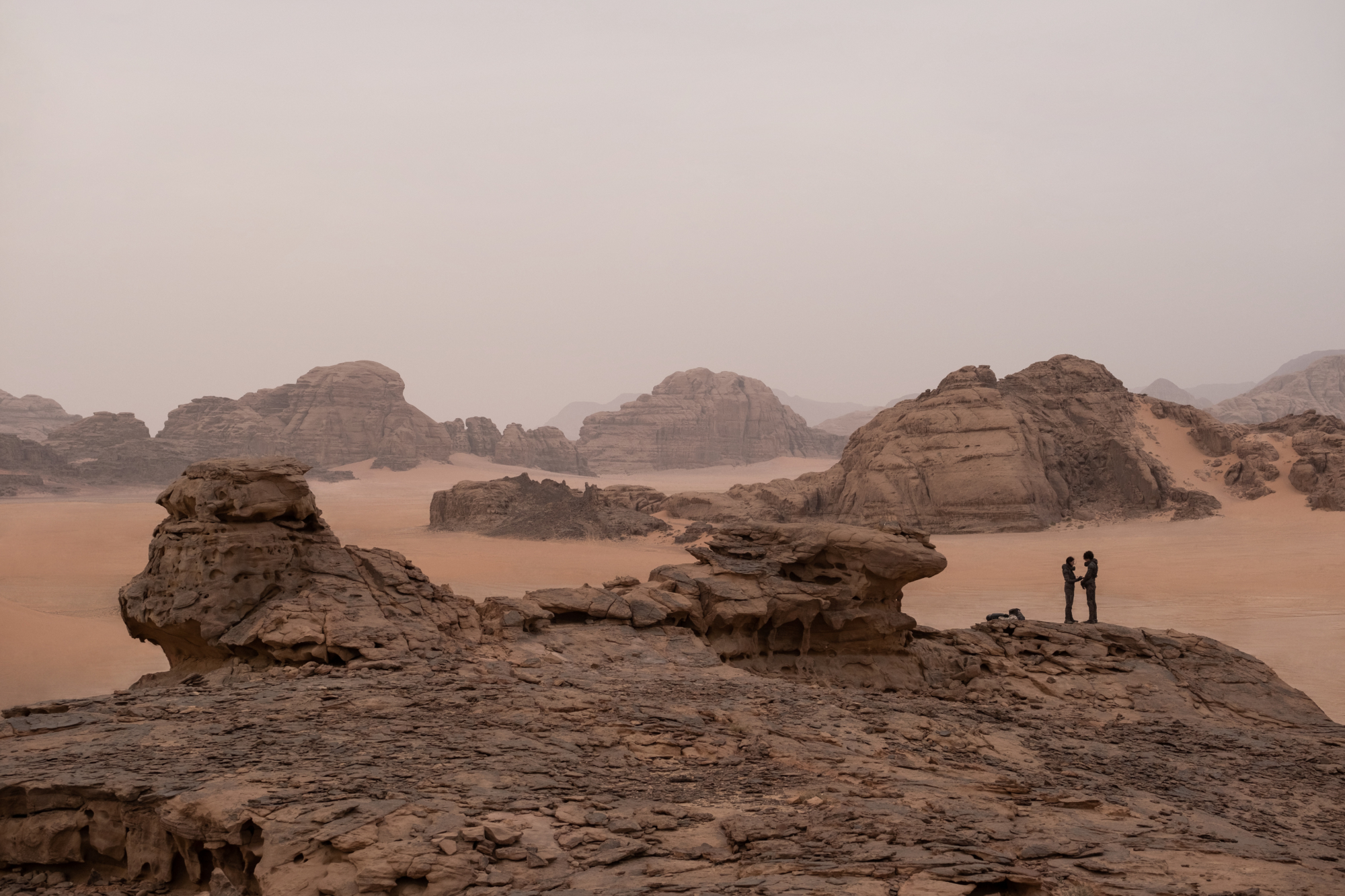As one of the most eagerly anticipated films of the past decade, Dune (Denis Villeneuve, 2021) is well suited to be the subject of a Cinema Science article. That anticipation stems, in part, from COVID-related delays; originally scheduled for wide release on 20 November 2020,[1]See Aaron Couch, ‘Denis Villeneuve’s Dune Sets Fall 2020 Release Date’, The Hollywood Reporter, 15 February 2019, <https://www.hollywoodreporter.com/movies/movie-features/dune-release-date-set-november-2020-1187372/>, accessed 1 February 2022. the star-studded blockbuster didn’t arrive in Australian cinemas until a full year after that date.[2]See Wenlei Ma, ‘Denis Villeneuve Says Dune Is “Sadly” More Relevant than Ever’, News.com.au, 6 September 2021, <https://www.news.com.au/entertainment/movies/new-movies/denis-villeneuve-says-dune-is-sadly-more-relevant-than-ever/news-story/d4f95d9d4f73d4425b0ca5f0fb42f4bd>, accessed 1 February 2022. More significant, though, is the shadow that its fictional universe has cast over the sci-fi genre. Frank Herbert’s 1965 novel of the same name – along with, to a lesser extent, the sequels that followed – is a foundational pillar of the genre, inspiring countless creators in the decades following its release. Star Wars, Star Trek and Avatar form just a sample of the towering franchises that wouldn’t exist without Herbert’s influence.
Which makes the half-century (and change) between the novel’s publication and the release of this film somewhat staggering. That’s partially explained by the failure of David Lynch’s best-forgotten 1984 adaptation, along with the sheer scale of Herbert’s universe. Villeneuve’s interpretation is immense in every sense, evoking a weightiness rarely seen in modern cinema – the film recalls Lawrence of Arabia (David Lean, 1962), whose DNA[3]If we’re splitting hairs, Herbert was probably influenced more by TE Lawrence’s real-life story than by his cinematic incarnation; nonetheless, there’s a neat circularity in the way Villeneuve draws upon Lean’s film in his adaptation. is inextricably woven into the original book. There’s so much going on that the story couldn’t even be contained in one (lengthy) film; look for Dune: Part Two to hit cinemas within the next couple of years.[4]The second film in the series has been scheduled for release in October 2023. See Ian Sandwell, ‘Dune 2 Release Date, Cast and Everything You Need to Know’, Digital Spy, 5 January 2022, <https://www.digitalspy.com/movies/a37662998/dune-2-release-date/>, accessed 1 February 2022.

The size of the Dune universe presents a galaxy of opportunities for Science teachers intending to incorporate pop culture into their classroom. I’ve chosen to narrow the focus here a little, however. Since so many of the film’s prominent elements are frequently found in its sci-fi compatriots – think: intergalactic travel, immense spaceships, terraformation of barren planets and telepathic powers – this instalment of Cinema Science will home in on three alliterative elements unique to Dune: stillsuits, shields and sandworms.
Surviving the desert
Dune takes its name from the nickname given to Arrakis, the desert planet: a world defined by the sweeping expanses of sand dunes dominating its surface. The difficulty of surviving in this environment – bereft of water and subjected to scorching heat during the day, much like our own deserts on Earth – is alluded to throughout the film’s first half, becoming critical when protagonist Paul Atreides (Timothée Chalamet) and his mother, Jessica (Rebecca Ferguson), are ejected from the planet’s capital city, Arrakeen, and abandoned in the barren landscape that surrounds it.

The critical tool that ensures their survival is the stillsuit, an invention of the Fremen, Arrakis’ indigenous inhabitants. As described in the film by Fremen leader Liet Kynes (Sharon Duncan-Brewster),
A stillsuit is a high–efficiency filtration system. It cools the body and recycles the water lost to sweat and other bodily fluids. Without one of these, you wouldn’t survive two hours, even in the morning. Your body’s movements provide the power.
At first glance, the premise seems plausible; the promise, enticing. Dehydration and heat stroke are interrelated threats facing anyone trying to navigate hot, dry environments. Wouldn’t it be great to be able to recycle our sweat (and other excretions) into water, and to use the mechanical power created by our own exertions to run a cooling engine? Why haven’t we come up with something like this? Let’s take these questions into the Science classroom, shall we?
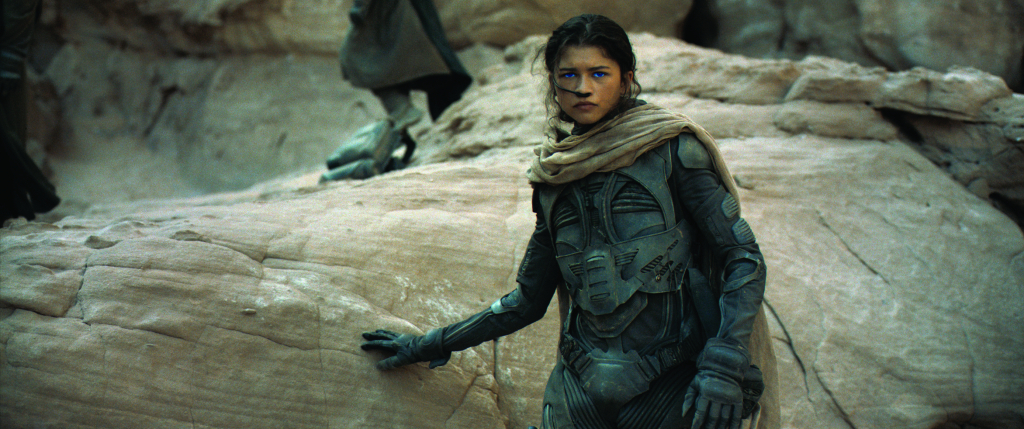
While stillsuits remain in the realm of science fiction, there are countless cooling garments specifically designed for hot environments.[5]Or for other applications, such as to aid those living with multiple sclerosis. These aren’t necessarily fancy; a light, long-sleeved top and long pants will do a lot by virtue of the material breathing and protecting the wearer from harsh sunlight and strong winds. Fancier features can be found in items like cooling vests – ranging from highly absorbent fabric that can be soaked in cool water to circulatory systems where ice-water can be pumped through the clothing to lower the user’s temperature. An exploration of existing garments like these will help provide students with some understanding of their underlying scientific principles.
Wouldn’t it be great to be able to recycle our sweat (and other excretions) into water, and to use the mechanical power created by our own exertions to run a cooling engine? Why haven’t we come up with something like this?
Stillsuits are clearly more advanced than a long-sleeved cotton shirt or a vest soaked in cold water, however; given the short supply of water on Arrakis, circulatory systems wouldn’t be especially effective in any case. It’s fair to assume that stillsuits work more like refrigerators, where the concomitant operation of a condenser and an evaporator cools the inside while heating the outside. The challenge with making such a ‘fridge suit’ is energy efficiency; by investigating the work that must be done by a fridge (or stillsuit) to transfer heat, students can understand these issues and reinforce their understanding of the relationship between heat and energy.

Then there’s the water problem. The technology to recycle water from other fluids exists – it’s called ‘reverse osmosis’. Students could explore the processes of reverse osmosis independently, and subsequently identify why it’s not suitable for stillsuits (mostly, it takes up way, way too much space). Beyond that – given that it’s safe to assume that reverse osmosis processes might be refined somewhat over the next 20,000 years – the major thermodynamic challenge of recycling water is presented by the aforementioned evaporation/condensation cycle. Sweat is a cooling mechanism when it evaporates; by instead relying on condensation, the stillsuits would increase the user’s body temperature. Again, there are plenty of sci-fi handwaves for this dilemma, but understanding the inherent problem will aid students in their understanding of fundamental thermodynamic concepts.
Shields up
One of the Dune franchise’s more distinctive innovations is its representation of energy-field-based ‘Holtzman’ shields. When Paul and his weapons master, Gurney Halleck (Josh Brolin), spar early in the film, the audience is introduced to blue-tinged auras that surround and protect these characters from otherwise lethal blows. It also becomes clear that these shields aren’t invulnerable; when a sword is pressed into an opponent’s shield slowly, the aura flashes red and eventually capitulates entirely.

These shields – and this vulnerability – are portrayed prominently as the film progresses and war ensues. When the villainous Harkonnens stage a late-night assault on the Atreideses’ stronghold, the bombs they drop defy gravity as they approach the ground, slowing to a crawl and slipping through the shields. A prominent character is assassinated by a ‘slow dart’, which similarly slips through their defences. In the books themselves, there are more dramatic interactions: the shields cause the equivalent of a thermonuclear explosion if fired upon by a device known as a ‘lasgun’.
Much like the stillsuits, such shields aren’t scientifically feasible based on our current technologies, but there’s much to explore in terms of how they might one day be realised. Blogger Zia Steele presents the possibility of using strong electromagnets to replicate the effect, using the phenomenon of diamagnetism – which ‘causes objects to be repelled by a magnetic field’[6]Zia Steele, ‘Can We Make Dune’s Shields?’, Whiteboard to Infinity, 27 October 2021, <https://medium.com/whiteboard-to-infinity/can-we-make-dunes-shields-51645b5fd1df>, accessed 2 February 2022. – to resist threatening collisions. Steele offers two important provisos, however: unlike Dune’s shields, this would be more effective against fast-moving objects than slower ones; and – perhaps more pertinently – ‘certain materials would be attracted to the strong magnets, making an enemy’s attacks more powerful’.[7]ibid.
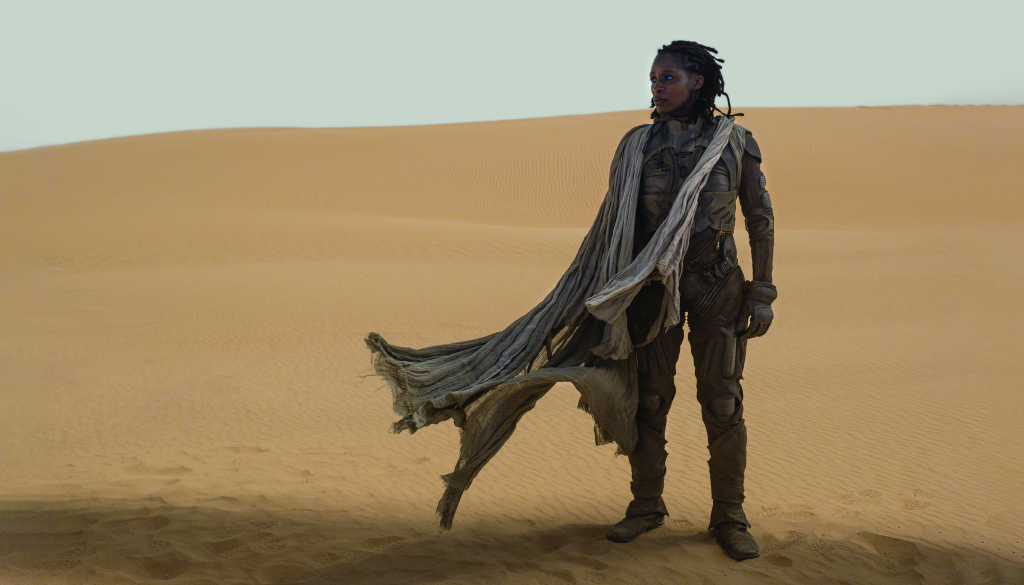
But discussing the vagaries of arms races and implements of war isn’t really within the remit of the Science classroom. Rather, Dune’s shields present an opportunity to consider the specificities of electromagnetic force – as well as, potentially, the other three fundamental forces of nature[8]These three other fundamental forces are categorised as gravitational, strong nuclear and weak nuclear. See ‘Fundamental Force’, Encyclopaedia Britannica, <https://www.britannica.com/science/fundamental-interaction>, accessed 2 February 2022. – both in and outside this context.
Beyond electromagnetic force, students could research different ways to simulate such shields either within the bounds of current science or in the near future. Steele proposes shear-thickening fluids and acoustic radiation pressure as alternative ways to create such protections,[9]Steele, op. cit. but as an exploratory, creative activity – grounded in scientific theories, of course – students would have free rein to conduct their own research and present it to their peers.
Say hello to Shai-Hulud
The most iconic image associated with Dune is undoubtedly that of the sandworms. Pick up a secondhand copy of the novel and you’ll likely find its cover bearing the mammoth monster’s gaping maw as the creature rears above a golden vastness. It’s hard to quibble with the sandworms’ effectiveness as a storytelling device; they represent a constant threat to our heroes as they traverse Arrakis’ deserts – at any moment, the peaceful swells of sand could be transformed into a huge mass of teeth and death. Equally, the sandworms encapsulate Paul’s narrative thrust, in terms of his need to work with Arrakis and the Fremen (who worship the worms, calling them ‘Shai-Hulud’) rather than dominate them. As the creatures’ attention is attracted by rhythmic movement, the Fremen have learned to both avoid detection through an irregular, dance-like way of walking and – as we learn right before the credits roll – even ride the worms, and the Atreideses too must learn to adapt to their existence.
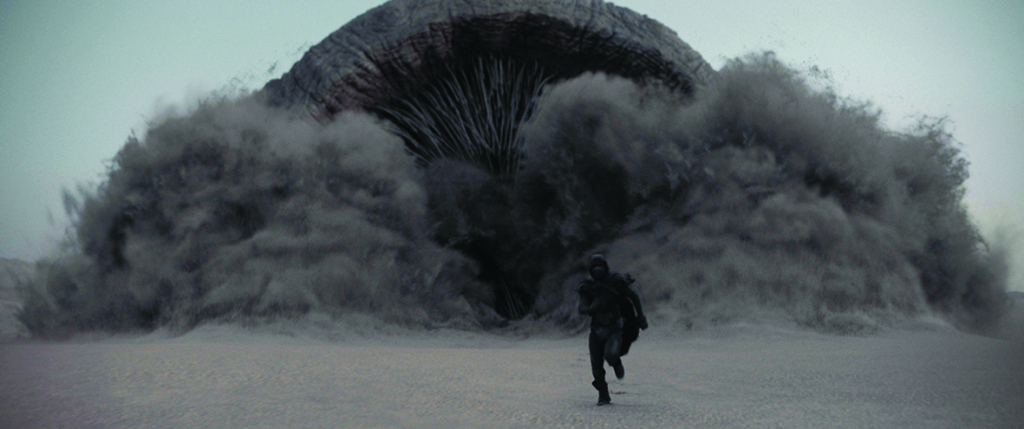
The sandworms are interesting for scientific reasons as well. Herbert’s realisation of the Dune universe was driven by an environmental consciousness that resonates decades later, and the sandworms reflect that in particular. Arrakis is imagined as a carefully attuned ecosystem riven by the galactic Empire’s colonising lust for ‘spice’ – a precious, hallucinatory resource found only on the desert planet – and the sandworms are a large part of that: they are perceived as a nuisance by newcomers, but recognised as integral to the planet’s balance by the Fremen. There are countless real-world ecological parallels in which the intrusion of humans mining resources has inextricably thrown ecosystems out of whack.[10]See Dharna Noor, ‘Humans Have Destroyed 97% of Earth’s Ecosystems’, Gizmodo, 15 April 2021, <https://gizmodo.com/humans-have-destroyed-97-of-earths-ecosystems-1846691917>, accessed 2 February 2022.
That said, I’m not convinced Dune is the best stimulus material for this conversation in the classroom. While the interplay between finite resources like water and desired resources like Arrakis’ spice is interesting, it’s relatively peripheral in the film proper. A more compelling question, in my view, is: could sandworms actually exist?
The short answer is almost certainly no, but unpacking why sandworms are biologically implausible opens a rich vein of analysis. Probably the best comparison[11]Credit to a Quora commenter, Tomaž Vargazon, for this comparison; Vargazon, answer to ‘Given What’s Known About the Dune Sandworms, How Much of Their Biology Is Possible?’, Quora, 31 December 2019, <https://www.quora.com/Given-whats-known-about-the-Dune-sandworms-how-much-of-their-biology-is-possible>, accessed 2 February 2022. is krill-feeding cetaceans like the blue whale, the largest animal on Earth. Sandworms sustain themselves on the spice sown through the planet’s sands, consuming it in huge quantities as they swim through the dunes. But whales that feed on krill use filters to ensure efficient eating; just how the sandworms are able to swallow tonnes of sand and only absorb the spice isn’t exactly clear given their enormous, toothy, predatory mouths. Those mouths seem custom-built to tear apart spice harvesters – as seen in the film’s first act – but poorly equipped for their primary mode of sustenance (and it seems very unlikely that the sandworms have evolved to consume said harvesters, unless evolution has accelerated incredibly rapidly in the previous 20,000 years).
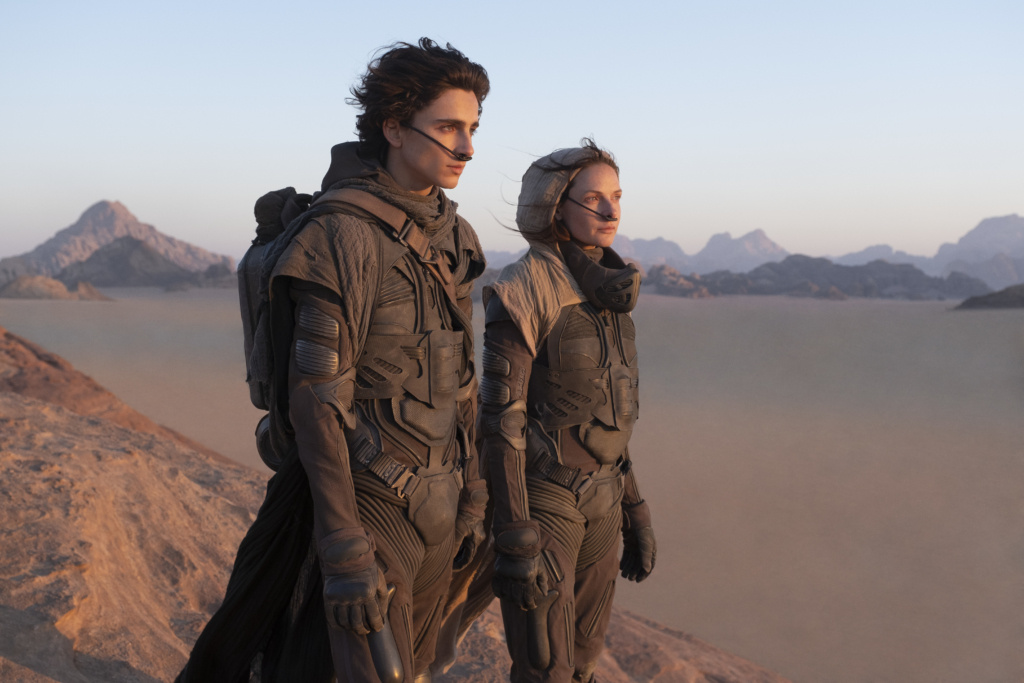
How exactly the sandworms are able to navigate the dense sands of Arrakis is another problem from a biological perspective. It’s not like it’s impossible to do so – plenty of animals burrow through sand – but these huge, wide beasts aren’t optimised for that kind of movement, let alone with the kind of smoothness with which we see them slide through sand. While not impossible, the energy output required would be astonishing. One can handwave these issues away – maybe spice is far more efficient an energy source than any food we’re aware of – but, realistically, these discrepancies are a consequence of Herbert attempting to re-create sea monsters on land. It’s a compelling image, and great for storytelling – just not necessarily grounded in science.
Endnotes
| 1 | See Aaron Couch, ‘Denis Villeneuve’s Dune Sets Fall 2020 Release Date’, The Hollywood Reporter, 15 February 2019, <https://www.hollywoodreporter.com/movies/movie-features/dune-release-date-set-november-2020-1187372/>, accessed 1 February 2022. |
|---|---|
| 2 | See Wenlei Ma, ‘Denis Villeneuve Says Dune Is “Sadly” More Relevant than Ever’, News.com.au, 6 September 2021, <https://www.news.com.au/entertainment/movies/new-movies/denis-villeneuve-says-dune-is-sadly-more-relevant-than-ever/news-story/d4f95d9d4f73d4425b0ca5f0fb42f4bd>, accessed 1 February 2022. |
| 3 | If we’re splitting hairs, Herbert was probably influenced more by TE Lawrence’s real-life story than by his cinematic incarnation; nonetheless, there’s a neat circularity in the way Villeneuve draws upon Lean’s film in his adaptation. |
| 4 | The second film in the series has been scheduled for release in October 2023. See Ian Sandwell, ‘Dune 2 Release Date, Cast and Everything You Need to Know’, Digital Spy, 5 January 2022, <https://www.digitalspy.com/movies/a37662998/dune-2-release-date/>, accessed 1 February 2022. |
| 5 | Or for other applications, such as to aid those living with multiple sclerosis. |
| 6 | Zia Steele, ‘Can We Make Dune’s Shields?’, Whiteboard to Infinity, 27 October 2021, <https://medium.com/whiteboard-to-infinity/can-we-make-dunes-shields-51645b5fd1df>, accessed 2 February 2022. |
| 7 | ibid. |
| 8 | These three other fundamental forces are categorised as gravitational, strong nuclear and weak nuclear. See ‘Fundamental Force’, Encyclopaedia Britannica, <https://www.britannica.com/science/fundamental-interaction>, accessed 2 February 2022. |
| 9 | Steele, op. cit. |
| 10 | See Dharna Noor, ‘Humans Have Destroyed 97% of Earth’s Ecosystems’, Gizmodo, 15 April 2021, <https://gizmodo.com/humans-have-destroyed-97-of-earths-ecosystems-1846691917>, accessed 2 February 2022. |
| 11 | Credit to a Quora commenter, Tomaž Vargazon, for this comparison; Vargazon, answer to ‘Given What’s Known About the Dune Sandworms, How Much of Their Biology Is Possible?’, Quora, 31 December 2019, <https://www.quora.com/Given-whats-known-about-the-Dune-sandworms-how-much-of-their-biology-is-possible>, accessed 2 February 2022. |
